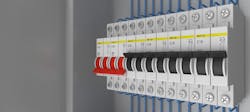Good Vibrations
A few years ago, a tool for vibration analysis on circuit breakers became feasible due to the incorporation of other tools, such as a condition based maintenance algorithm. It’s called “circuit breaker vibration analysis” and is often abbreviated as CBVA.
CBVA provides a 3D graph that can be quantitatively analyzed to provide insight into the condition of the breaker. One big advantage of CBVA is it can be used to collect first trip data. Prior to CBVA, the normal practice in breaker maintenance was to manually open the breaker before performing any maintenance. This means losing the first trip data forever. Therefore, you’d have no idea if that breaker would actually have opened when it is supposed to.
This is important because most breakers sit with no maintenance, or the maintenance that is performed is incorrect or inadequate. By capturing first trip data, you can evaluate the maintenance that has been performed (or not) on that breaker.
CBVA testing requires operating the breaker, so performing it requires coordination with the operations people, but it doesn’t necessarily require a scheduled shutdown as does normal breaker maintenance. You could use it as an interim test procedure, especially if equipment undergoes routine switching (e.g., shift changes).
